Vietnamese Fried Spring Rolls – Nem Rán/Chả Giò (Plus Tips for Extra Crispiness)
Vietnamese Fried Spring Rolls are delicious with crispy exterior and flavorful filling. This dish is a must in any traditional Vietnamese banquets or celebrations. I am sharing the authentic way to make them as well as tips to ensure they turn out golden and crispy.

There are two main categories of spring rolls in Vietnam: the fresh ones (called gỏi cuốn) and the fried ones. Vietnamese people call the fried version nem rán (usually in Hanoi), chả nem (like in my hometown) or chả giò (in the South of Vietnam).
Depending on the regions, the filling may be slightly different, but it usually contains ground pork, shrimp, and a variety of shredded veggies. My hometown is a seaside city, so people often add crab meat and mantis shrimp is becoming a popular addition lately. The filling is then wrapped with a spring roll wrapper and fried until golden and crispy.
Outside of Vietnam, some people call them egg rolls, but I personally avoid using those words to call Vietnamese traditional fried spring rolls. I don’t want to have an impression that they are made with egg roll wrappers which are not the same as the Vietnamese ones.
As mentioned at the beginning, this dish is a must in any Vietnamese traditional feasts or banquets, such as Lunar New Year. It is actually also great for everyday meal since you can make it ahead and freeze for later.
Watch How to Make these Crispy Spring Rolls
Subscribe to our Youtube channel for more easy-to-follow cooking videos!
Ingredients
The recipe I’m sharing today is an authentic Northern-style fried spring rolls. Here are the main ingredients:

- spring roll wrappers: these white sheets are made from rice flour and sun-dried before packaged and sold to consumers. In Vietnam, we don’t use spring roll pastry or egg roll wrappers to make cha gio.
- ground pork and chopped shrimp: I often use a 50-50 or 60-40 ratio of pork to shrimp. When we have fresh crab meat on hand, I also love to add it to the filling.
- glass noodles (miến, also called cellophane noodles or mung bean thread noodles): you can find these at Asian grocery stores. Make sure you choose Vietnamese or Chinese glass noodles. The Korean ones are not suitable for this dish.
- dried wood-ear mushrooms: these add crunchiness to the filling.
- shredded carrot and beansprouts: these are among the most popular veggies used in spring roll filling. Some people like to use jicama or kohlrabi. When I was in the US., I sometimes took a shortcut by using a bag of slaw with pre-shredded cabbage and carrot.
- eggs, shallot, fish sauce, salt and pepper
The Southern Vietnamese rolls have a slightly different filling. Instead of using glass noodles, people like to add shredded sweet potatoes or taro.
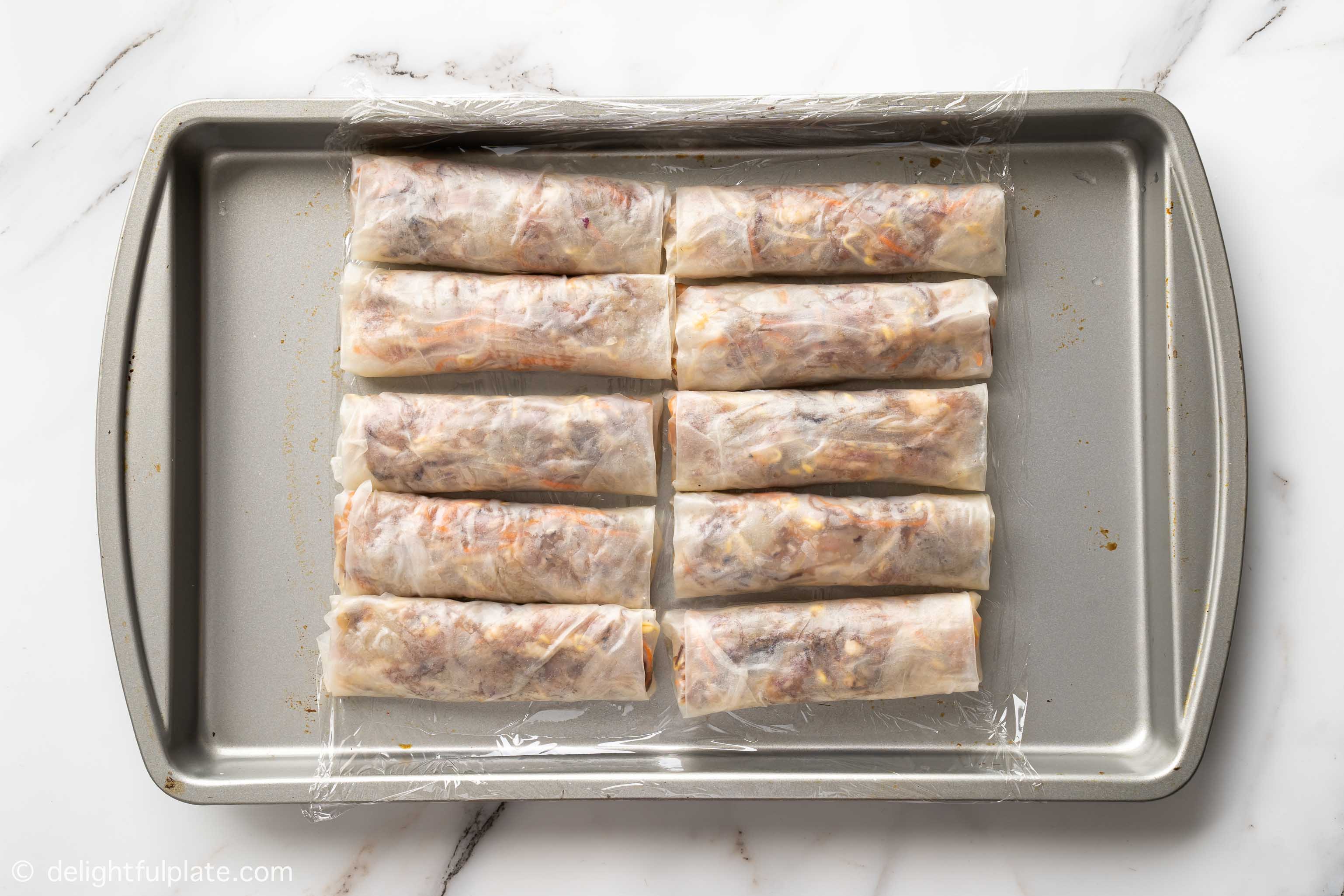
Don’t Wrap Too Tight
Nem rán (or chả giò) is not difficult to make at all, although if you make a large batch, it can be quite time-consuming to wrap the rolls. First, you will need to slice or cut ingredients into small pieces and then mix them well to combine.
The next step will be wrapping. Use your fingertips to dab water over the wrapper to make it pliable, then add the filling and roll. Here’s a very important thing: when you make these spring rolls, do not wrap too tight, or the rolls may burst when you fry them. The reason is the noodles in the filling will expand when frying.

My Family’s Tips For Extra Crispiness
One of the things that make this dish tasty is its crispy exterior. In order to achieve that, here are my family’s tips:
- Add just a few drops of vinegar to the water you will use to dab over the spring roll wrappers
- Fry twice: first time with medium heat to cook the interior and second time to crisp up the exterior
- Use a generous amount of frying oil
- Fry the rolls in a single layer and leave some room to move them around. Overcrowding the pan will lower the heat too much and the rolls may not turn out crispy
How to Serve
It is best to eat the rolls right after the second fry. If you plan to eat them the next day, do the first fry, refrigerate them, and do the second fry either on the stovetop or in an air-fryer the next day.
If you want to freeze the rolls for later, do so after the first fry. When you need to serve them, let them thaw a bit and then refry on the stovetop or in an air-fryer.
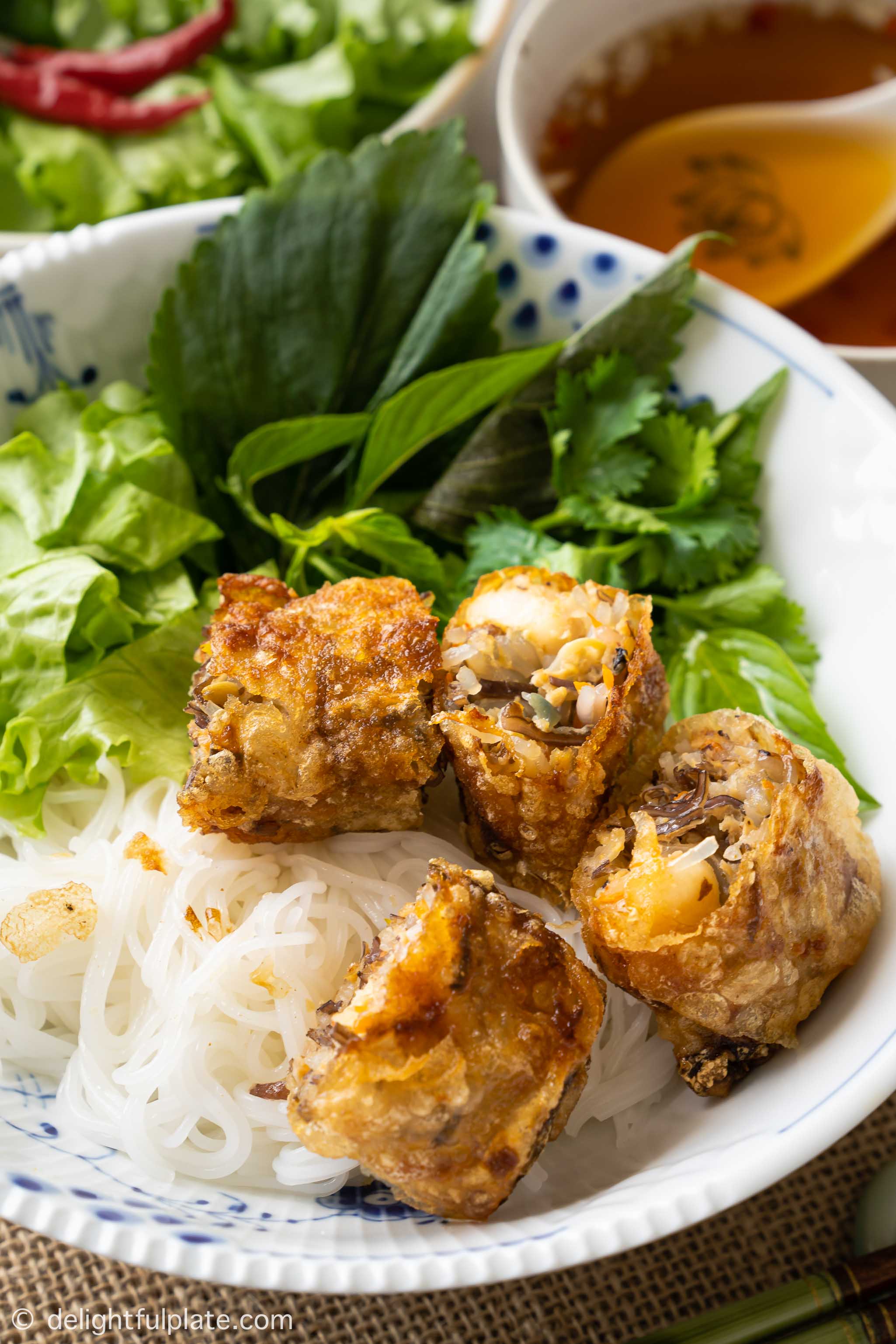
The most common way to serve these is with rice vermicelli noodles, soft lettuce, fresh herbs and nuoc cham dressing. There is a variety of herbs you can use: cilantro, Thai basil, spearmint (peppermint is fine too), and perilla leaves.
⭐️ I’d love to hear what you think about the dish, so please feel free to leave a comment and a rating if you have tried it. New recipes are added every week so let’s connect on Facebook, Youtube, Pinterest and Instagram for the latest updates. You can find my collection of Vietnamese recipes here.
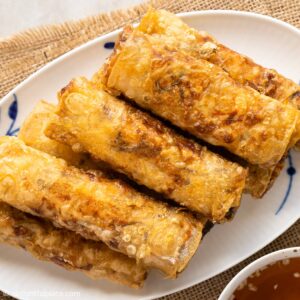
Vietnamese Fried Spring Rolls (Nem Rán/Chả Giò)
Ingredients
For the Spring Rolls
- 0.5-0.6 oz dried wood-ear mushrooms
- 1.75 oz dried glass noodles
- 9.5 oz raw peeled and deveined shrimp
- 10.5 oz ground pork
- 3.5 oz beansprouts
- 1.1 oz carrots, julienned
- 2 1/2 tablespoons minced shallots
- 1/2 teaspoon salt
- 1 1/2 teaspoons black pepper
- 1 teaspoon fish sauce
- 2 medium to large eggs
- 1 cup water
- 1/8 teaspoon rice vinegar
- 16-18 spring roll wrappers
- frying oil
To Serve
- rice vermicelli noodles
- soft lettuce
- fresh herbs such as cilantro, mint, Thai basil
- nuoc cham dressing (See Notes for suggestions on how to make it)
Instructions
- Soak dried wood-ear mushrooms in hot water for 5 minutes or until rehydrated, then julienne. Soak glass noodles in room-temperature for about 20 minutes. Once softened, cut noodles into shorter pieces, about 2-3 inch long.
- Chop shrimps into smaller pieces but not too small. Place shrimp pieces and ground pork in a mixing bowl. Then add julienned wood-ear mushroom, beansprouts, carrot, glass noodles, shallots, salt, pepper and fish sauce. Give everything a quick mix. Then add 2 eggs and mix well to combine.
- Before wrapping the rolls, you can fry a small piece of filling to see if it is seasoned to taste and adjust if needed.
- To a small bowl, add about 1 cup of water and a few drops of rice vinege (about 1/8-3/16 teaspoon). Place a spring roll wrapper on a clean surface and use your fingertips to dab some water from the bowl to wet the wrapper.
- Once the wrapper sheet is pliable, place about 2½ tablespoons of filling near the top part of the sheet. Form the filling into a log shape, then fold the left and right sides of the rice paper over the filling. Fold the top part of the sheet over and then roll it up away from you. Set aside. Continue to wrap until you have used up all the filling.
- Place a frying pan over medium heat. Once the pan is hot, heat a generous amount of oil. When the oil is hot, add the spring rolls and fry in a single layer. You may need to increase the heat slightly after adding the rolls to ensure the oil is hot and bubbling (not too vigorously). Fry for 4-5 minutes until the outside is lightly golden, flip once or twice. Transfer to a wired rack or place on paper towel briefly to absorb excess oil.
- Let the rolls cool down for 5-10 minutes. Then heat the oil again over medium heat and fry the rolls the second time. This time, use a slightly higher heat than the first time to crisp them up. Fry for 2-3 minutes until the outside is deep golden and crispy. Transfer to a wired rack or place on paper towel briefly to absorb excess oil before serving.
- Serve right away with noodles, lettuce, fresh herbs and dressing.
Notes
- 1 cup (240ml) warm water
- 1 tablespoon granulated sugar
- 3 tablespoons fish sauce
- 2 tablespoons lime juice
- 2 teaspoons mince garlic
- bird’s-eye chili, minced (optional)
- In a bowl, mix together water, sugar and fish sauce. Let it cool slightly then add lime juice. Taste and adjust to your liking. Then add garlic and chili.
Nutrition

In a traditional Vietnamese feast such as for Lunar New Year celebration, nem ran/cha gio is served with a selection of savory dishes, including poached chicken, sticky rice, soup and stir-fry. Here are other traditional dishes we like to serve in such feast:


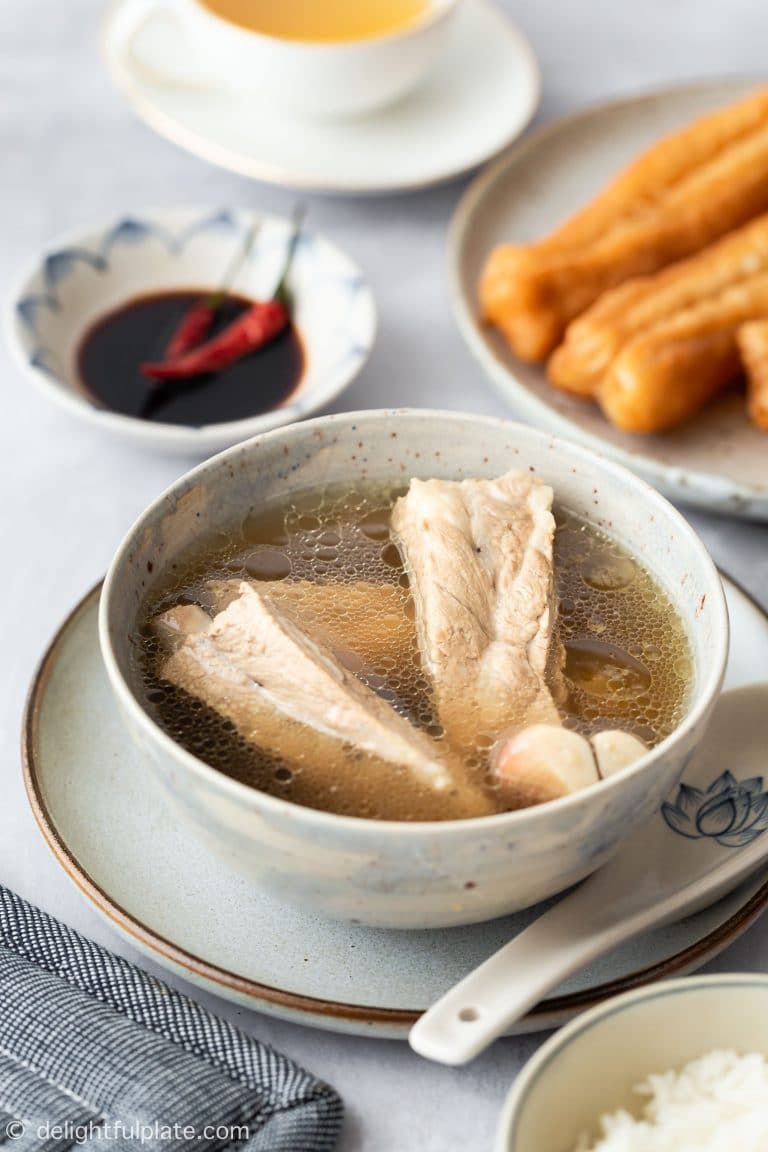



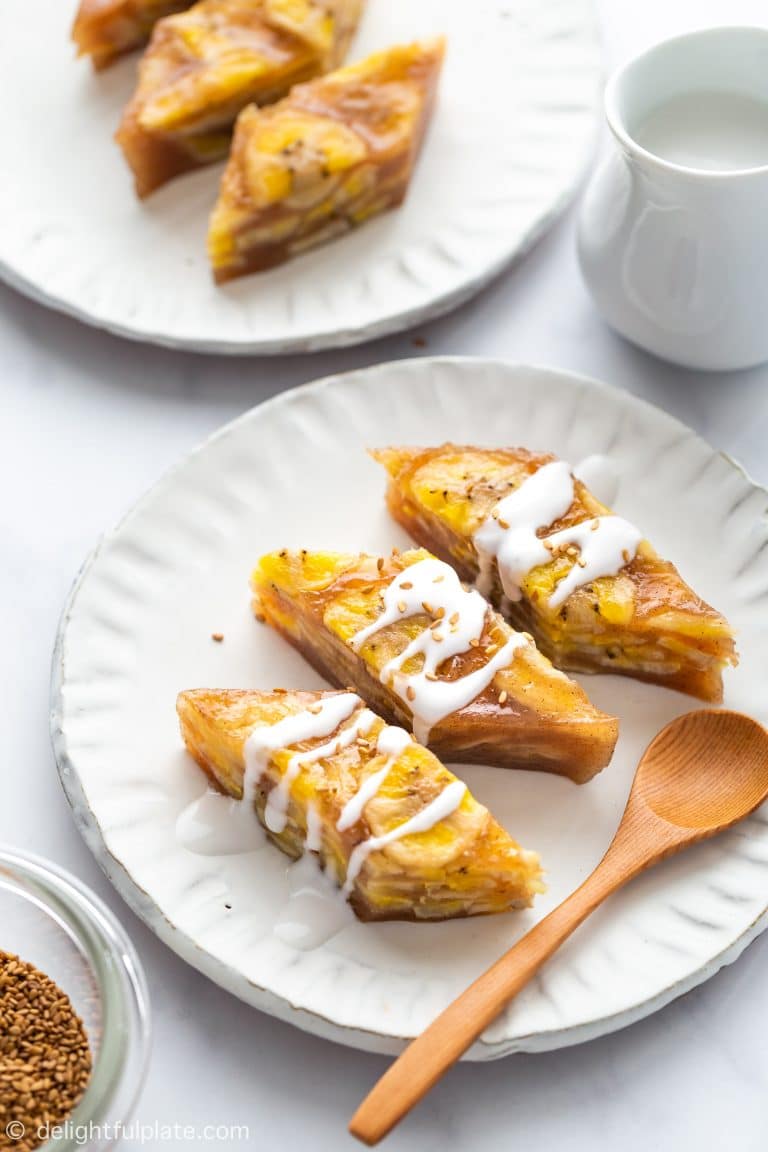
These look amazing! Going to try making these this weekend.
Question: Is there a substitution I can make instead of using the fish sauce? Thanks!
Hi Ana,
If you don’t want to use fish sauce, I think you can increase the amount of salt in the filling instead. For the dipping sauce, I haven’t made one without fish sauce yet. You might try simmering water, salt, sugar, fresh pineapple juice and some soy sauce, and then add lime juice. Vegetarian places in Vietnam often use pineapple juice in their dipping sauce.
Very ngon
I have frozen my rolls after the first fry. Would I be able to air fry them for the second fry from frozen?
Hi Emma,
My family usually lets the rolls thaw (either in the fridge or on the counter) before air-frying them. I haven’t tried air-frying them straight from the freezer.
I tried this recipe and the roles were delicious! My only trouble was not reading all the comments. I did not use the vinegar and it was difficult to brown the rolls. However they still turned out amazing! I too was wondering what type of oil might be helpful. I use sunflower oil.
Thanks!
Hi Laurie,
Thank you for the comment! I’m glad the rolls turned out delicious. I usually just use whatever vegetable oil for frying I have on hand. It’s been rice bran oil for the last couple of years.
How much oil did you use? Using a generous amount of oil (like almost enough to cover the rolls) can help with browning them, as well as increase the heat a bit toward the end. I think sunflower oil should work fine. The vinegar will help with creating small bubbles on the surface, making the spring rolls crispier.
If you give it a try again, please let me know how it works this time.
Hey Sophie,
Could you tell me the specific Brand that You used in this frying recipe?
I’d like to get that bubbling effect when you fry as that’s the texture my girlfriend likes
Hi Kevin,
So sorry I missed your question. The rice paper wrappers I use is from a Vietnamese brand made in a craft village called “Làng Chều”. The village specializes in making rice paper in Northern Vietnam. It’s the brand my family has been using for many years, and I always brought them from Vietnam during the years I lived in the US. Their wrappers are fairly thin.
It’s kinda a matter of trial and error to find the brand that gives you the right thickness and texture. A touch of vinegar added to the water to dab the wrappers can help with the bubbling effect on the surface.
So these “spring roll wrappers”, it is different than rice paper, right? What is the Vietnamese name for the wrappers?
Hi Chris,
These spring roll wrappers are also a type of rice paper. In Vietnam, rice papers are labeled specifically whether they are for fried rolls or fresh rolls. I find the one used for fried spring rolls are often thinner. We (as Northern Vietnamese) call them “bánh đa nem”, and I think people in the South call them “bánh tráng”. And rice papers for fried spring rolls do vary greatly in terms of quality. Some may turn out crispier than others, so you may need to try several brands to find the ones you are happy with.
I hope this makes sense :).
Hi Sophie! Thanks for the response. That helps!
For the frying oil, is there a preferred type of oil? Also, what is the temp that you recommend, as different oils have different smoking points?
Hi Chris,
Hmm, I think any oil that can be used for deep frying will work. Vietnamese home cooks often use vegetable oil purchased at normal grocery stores. In the last couple years, rice bran oil has gotten quite popular here, so I’ve been using rice bran oil to fry these rolls (and other food too). It is said to have a high smoke point.
For the first fry, you should use medium heat to let the inside cook through. You can try 160-175C (325-350F), so you should see gentle small bubbles when frying as in the video. Then use higher heat to crisp up when you fry the second time (or if you want to feel a bit healthier, fry the second time in an air-fryer which is what my mom likes to do these days).
Rice papers 16 or 22 cm?
Hi Attilio,
Mine is 21.5cm in diameter. The 22cm will work well. I think 16cm is a little small, but you can reduce the amount of filling to make it work.
Hi there: Terrific recipe….I have put some of the vietnamese spring rolls in the freezer after the first fry…..just wondering….do I thaw them out to refry….fry from frozen….or pop in oven frozen to bake?
Hi Bev,
Thanks so much for trying the recipe! So you can either fry them directly from frozen or let them thaw a bit before refrying. I have done it both ways (depending on whether I planned ahead for dinner or not) and both work. If you fry them directly from frozen, there can be some oil splattering, and please adjust the heat as needed so that the inside is hot all the way through while the outside isn’t burnt. I have never put them in the oven, but my guess is it won’t work very well.
I hope this helps!